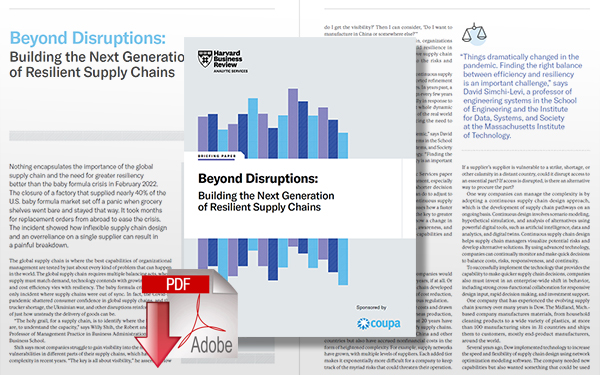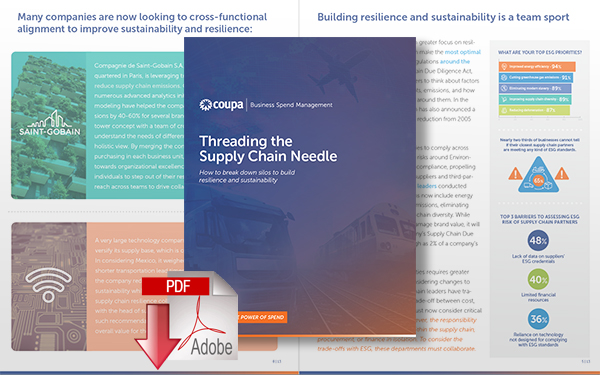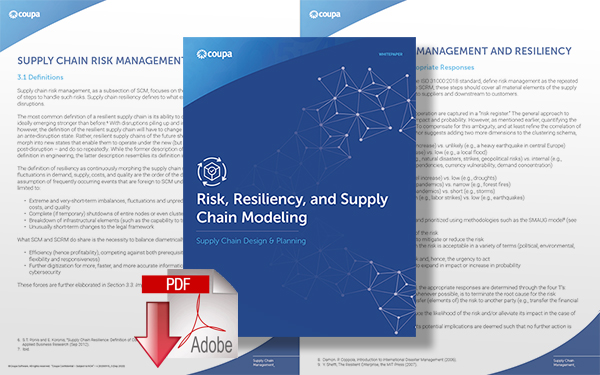5 Ways Supply Chains Can Flourish in an Inflationary World

Supply chain and procurement professionals are being called to manage their organizations' value chains in highly challenging macroeconomic conditions, it is important to have visibility into inflation indices like the consumer price index and producer price index inflation.
Significant challenges in the global economy
It would be an understatement to say that the global economy is facing significant challenges today.
One particular challenge receiving a lot of attention is Consumer Price Index (CPI) inflation.
But there is another index that is less talked about but is important for supply chain and procurement professionals to pay attention to, the Producer Price Index (PPI).
Keeping a keen eye on this index can help supply chain and procurement professionals optimize their business spend.
A CPI is a price index: the price of a weighted average market basket of consumer goods and services purchased by households.
Since there is an intermediary, namely the retailer who sets the price for goods and services for consumers, this index does not directly reflect the supply chain costs.
On the other hand, the PPI provides an interesting perspective on the impact of supply chain disruptions and resiliency. The PPI inflation index measures the average change over time in the selling prices received by domestic producers for their output.
The US Producer Price Index, which tracks what America’s producers get paid for their goods and services, rose at an annual pace of 8.5% in September, down slightly from the 8.7% rise in August, the Labor Department reported Wednesday, October 12.
But the report showed prices rose 0.4% month-over-month. It was this monthly increase that caused turmoil in the market on Thursday, October 13 before it bounced back in dramatic fashion. It is hard to fathom the rationale as to how the equity markets behave, but as supply chain professionals we can at least focus on the impact that the PPI inflation indices have on them.
What can retailers and manufacturers do to mitigate the increased prices at which they need to purchase the products?
Given the high CPI inflation rates, retailers and manufacturers are increasing the prices to consumers. Consumers are feeling the pinch when they go to the grocery store or the gas station. But there is a limit to this approach. Consumers will flock to the competitors to gain better pricing.
So what are the other longer-term and systematic methods that manufacturers and retailers can adopt?
1. Optimize the form and function of the inventory
The impact of the high PPI and high-interest rate environment is that it deals a double blow to manufacturers and retailers. The price at which they purchase products increases, as do inventory carrying costs. The initial reaction from managers might be to indiscriminately cut down inventory across the board.
However, the challenge is that consumers are also feeling the pinch and any buying decision they make is based on price as well as availability. If the product they are interested in is not available then they will go to the next competitor and buy that product. So the right form and function of inventory have to be placed at the right place, right time, and right price. This is an inventory optimization problem and there are some good strategies to handle this problem.
2. Optimize business spend
While some organizations are considering layoffs, many executive teams would rather refocus their investments and increase efficiency. It’s a shift from focusing predominantly on growth to a balance of growth and profitability. Getting visibility into all spend, whether direct or indirect, and diligently cutting down spend while not impacting performance is key to surviving the current business climate. There are some great approaches to getting started with managing business spend.
3. Build better relationships with suppliers
Understandably, suppliers are feeling the pinch of increased costs and henceforth sell their products at a higher price to manufacturers, compounding the PPI increase year over year. However, a strategic relationship with suppliers built on solid foundations of trust and visibility can help mitigate these dramatic price increases.
Manufacturers have to remember that they cannot negotiate down their suppliers in supply-constrained environments. One of the prerequisites for improved supplier relationships is to have a common version of the truth for all interactions that happen with the suppliers.
4. Embrace long term demand sensing
The CPI and PPI are macroeconomic parameters that can have a significant impact on long-term demand modeling, financial forecasting, and supply chain design. It is surprising to see that very few companies model long-term demand futures based on these macroeconomic causal factors and perform scenario analyses.
Hopefully, the extreme upswings and downswings that the economy is seeing will encourage supply chain strategy professionals to look into building out more resiliency models based on long-term demand modeling.
5. Develop continuous supply chain design competencies
Structural changes in the demand market along with supply chain disruptions mean that companies need to embrace continuous supply chain design so they can pivot quickly and adjust to new supply chain constraints and to new business opportunities.
In summary, supply chain and procurement professionals are being called to manage their organizations' value chains in highly challenging macroeconomic conditions. It is important to have visibility into inflation indices like CPI and PPI. More importantly, understanding what levers they can pull to manage inflationary pressures is absolutely critical
To learn more about ways to manage inflationary pressures and create resilient supply chains, explore the report from Harvard Business Review Analytics Services in association with Coupa.
About the Author
Nari Viswanathan is currently Sr. Director of Product Segment Marketing at Coupa, where he helps bring products to markets in the areas of Supply Chain Design and Planning. Over the past 20 years, Nari has held VP and Director of Product Management, Research, and Marketing roles at Aberdeen Group, River Logic, Steelwedge, and E2open. He has significant experience building products from the ground up and managing the P&L for a product suite. Nari holds a master’s degree in Manufacturing Systems Engineering from the University of Wisconsin-Madison and a bachelor’s degree in Mechanical Engineering from the Indian Institute of Technology, Chennai.
Related Resources
Beyond Disruptions: Building the Next Generation of Resilient Supply Chains
This Harvard Business Review briefing paper examines how leading companies are creating tremendous value by embracing these practices and captures insights from recognized thought leaders on building resilience and agility, which have become strategic differentiators. Download Now!
The New Competitive Edge - Analytics-Driven Supply Chain Design
This executive guide, developed in collaboration between the Massachusetts Institute of Technology’s Center for Transportation & Logistics (MIT CTL) and Coupa, presents a vision for future-proof, analytics-driven supply chain design. Download Now!
Threading the Supply Chain Needle
Learn how to break down departmental silos and design resilient and sustainable supply chains. Download Now!
Continuous Design Outsmarts Disruption: A Blueprint for Supply Chain Resiliency
In this ebook, we discuss how continuous design can reduce risk, improve resilience, and turn supply chain challenges into a competitive advantage. Download Now!
Risk, Resiliency, and Supply Chain Modeling
This paper first examines why existing supply chain management practices do not naturally develop resilient supply chains and why some of the existing supply chain processes are not suitable for addressing such risks and required responses. Download Now!
More Resources from Coupa
Related Article: Build Resilience in Supply Chains by Modeling & Designing Multiple Demand Futures
Article Topics
Coupa News & Resources
How Microsoft Improved ESG & Sustainable Spending Working Together with Community.ai Capabilities Supply Chain Agility in an Ever-Changing World How Sourcing Can Respond in Dynamic Markets to Drive Supply Chain Value Build Resilience in Supply Chains by Modeling & Designing Multiple Demand Futures Beyond Disruptions: Building the Next Generation of Resilient Supply Chains 6 Truths About Business Spend Management Technology 5 Ways Supply Chains Can Flourish in an Inflationary World More CoupaLatest in Supply Chain
Apple Accused of Multiple Human Rights Violations UPS Struggles in First Quarter With Steep Earnings Decline How Supply Chains Are Solving Severe Workplace Shortages SAP Unveils New AI-Driven Supply Chain Innovations How Much Extra Will Consumers Pay for Sustainable Packaging? FedEx Announces Plans to Shut Down Four Facilities U.S. Manufacturing is Growing but Employment Not Keeping Pace More Supply Chain




















